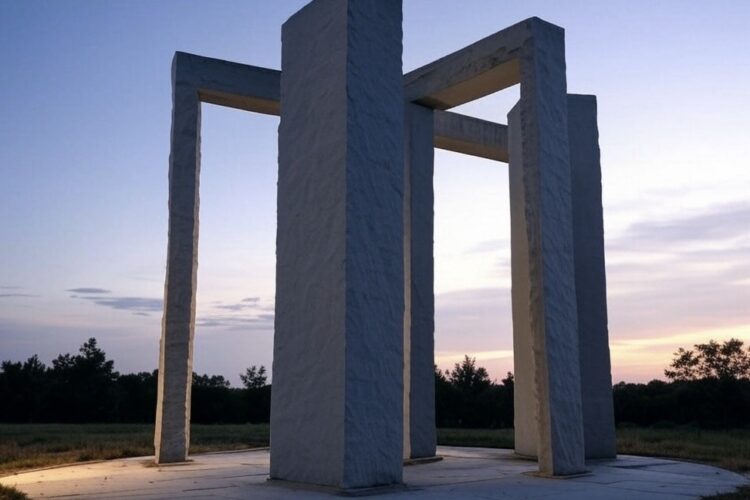The Georgia Guidestones, a granite monument in Elbert County, Georgia, stood from 1980 until its destruction in 2022. Commissioned by the anonymous R.C. Christian, the structure featured ten guidelines in eight languages, urging population control, unity, and harmony with nature. Its cryptic inscriptions and alleged astronomical alignments sparked conspiracy theories about a New World Order, eugenics, and occult ties. Vandalism plagued the site, culminating in an explosive attack that led to its demolition. Though gone, the Guidestones remain a symbol of mystery, drawing tourists and fueling online debates about their true purpose.
Long Version
In the quiet, rural expanse of Elbert County, Georgia, a colossal granite monument once stood as both a tourist attraction and a lightning rod for speculation: the Georgia Guidestones. Erected in 1980, this enigmatic structure, often dubbed the “American Stonehenge,” was a marvel of engineering, a cryptic manifesto, and a canvas for conspiracy theories. Known for its multilingual inscriptions, alleged astronomical alignments, and anonymous origins, the Guidestones sparked fascination and debate until their destruction in 2022. This article delves into every facet of the Georgia Guidestones—its history, design, inscriptions, controversies, and cultural impact—offering a definitive resource on this peculiar landmark.
Origins and Construction: The Enigma of R.C. Christian
The story of the Georgia Guidestones begins in 1979, when a man using the pseudonym R.C. Christian approached the Elberton Granite Finishing Company with an ambitious proposal. Claiming to represent “a small group of loyal Americans,” Christian commissioned a monument to serve as a guide for future generations in a post-apocalyptic world. His anonymity, combined with the project’s scale, intrigued Joe Fendley, the company’s president, who agreed to oversee construction. Wyatt Martin, a local banker, was enlisted as the intermediary, handling financial transactions and signing a confidentiality agreement to protect Christian’s identity. To this day, Martin, who passed away in 2021, remains the only known person to have met Christian, and he took the secret to his grave.
The Guidestones were erected on a hilltop in Elbert County, a region renowned for its granite industry. Unveiled on March 22, 1980, the monument consisted of five massive granite slabs, each over 16 feet tall, arranged in a star-shaped pattern, topped by a smaller capstone. A sixth slab, set at ground level, provided explanatory details. Weighing over 237,000 pounds, the structure was a testament to Elberton’s craftsmanship and a beacon of mystery in an otherwise unassuming landscape.
Christian’s stated intent was to create a set of guidelines for rebuilding civilization after a cataclysmic event. However, the secrecy surrounding his identity and the monument’s inscriptions fueled speculation about his affiliations, with theories linking him to groups like the Freemasons, Rosicrucians, or even a banking elite orchestrating a New World Order. Some suggested Christian’s pseudonym hinted at Rosicrucianism, a mystical order emphasizing esoteric knowledge. Despite exhaustive investigations, no definitive evidence has surfaced to unmask Christian or his backers, cementing the Guidestones’ status as an enduring enigma.
Design and Features: A Monument of Precision
The Georgia Guidestones were as much an architectural feat as a philosophical statement. The monument’s design incorporated precise measurements and alleged astronomical alignments, sparking debates about its purpose. The five upright slabs, each inscribed with guidelines, were arranged to align with celestial events, such as the equinoxes and the Polaris star, visible through a small hole in one slab. A slot in another slab marked the sunrise and sunset during the equinox, suggesting a calendar-like function. These features led some to speculate about occult or astrological significance, though others viewed them as practical tools for a future agrarian society.
The capstone, weighing over 20,000 pounds, bore inscriptions in four ancient languages—Babylonian cuneiform, Classical Greek, Sanskrit, and Egyptian hieroglyphs—translating to a message about the monument’s purpose: “Let these be guidestones to an Age of Reason.” A nearby explanatory tablet detailed the monument’s dimensions, languages, and construction date, hinting at a time capsule buried beneath, though its existence was never confirmed. The use of granite, a material synonymous with durability, underscored the Guidestones’ intended longevity.
The inscriptions on the upright slabs were carved in eight modern languages: English, Spanish, Swahili, Hindi, Hebrew, Arabic, Chinese, and Russian. This multilingual approach suggested a global audience, reinforcing the monument’s universal aspirations. The choice of languages, however, puzzled observers, as some (like Swahili) were less widely spoken globally, while others (like French or German) were omitted. This quirk only deepened the monument’s mystique.
The Inscriptions: A Blueprint for Humanity or a Dystopian Agenda?
The heart of the Georgia Guidestones lay in its 10 Commandments, a set of guidelines etched into the granite slabs. These directives, intended to guide a future civilization, were both idealistic and contentious:
- Maintain humanity under 500,000,000 in perpetual balance with nature.
- Guide reproduction wisely—improving fitness and diversity.
- Unite humanity with a living new language.
- Rule passion—faith—tradition—and all things with tempered reason.
- Protect people and nations with fair laws and just courts.
- Let all nations rule internally resolving external disputes in a world court.
- Avoid petty laws and useless officials.
- Balance personal rights with social duties.
- Prize truth—beauty—love—seeking harmony with the infinite.
- Be not a cancer on the Earth—Leave room for nature—Leave room for nature.
These principles, while seemingly benign in their call for harmony and sustainability, ignited fierce debate. The first guideline, advocating for a global population of under 500 million, was particularly polarizing. In 1980, the world’s population was around 4.4 billion, meaning the guideline implied a drastic reduction. Critics interpreted this as a call for depopulation or eugenics, linking the Guidestones to conspiracy theories about Agenda 21, a United Nations sustainability initiative, or a deep state plot. The second guideline, urging “wise” reproduction, further fueled accusations of eugenics, evoking historical fears of forced sterilization or genetic manipulation.
Other guidelines, like the call for a “new language” or a “world court,” were seen as endorsing globalism or a one-world government, concepts anathema to advocates of national sovereignty. The emphasis on reason over passion and tradition alienated religious groups, who saw the Guidestones as promoting secularism or even Satanism. Conversely, supporters viewed the inscriptions as aspirational, advocating for environmental stewardship, justice, and unity in a fractured world.
Controversies and Conspiracy Theories: A Magnet for Speculation
From the moment of their unveiling, the Georgia Guidestones were a lightning rod for controversy. Their anonymous origins, cryptic inscriptions, and grandiose ambitions invited speculation about their true purpose. Conspiracy theorists posited that the Guidestones were a manifesto for the New World Order, a shadowy cabal allegedly seeking global domination. The monument’s call for population control was interpreted as evidence of a genocidal agenda, with some claiming it endorsed human sacrifice or mass culling orchestrated by global elites.
The Guidestones’ alleged occult connections were another focal point. The monument’s astronomical alignments and ancient-language inscriptions led some to link it to esoteric traditions like Freemasonry or Rosicrucianism. A swastika graffitied on the stones in the 2000s (later removed) fueled claims of neo-pagan or supremacist ties, though no evidence supported these assertions. Religious groups, particularly evangelical Christians, decried the Guidestones as a Satanic monument, citing their secular tone and perceived challenge to biblical authority.
Vandalism was a recurring issue. The Guidestones were defaced multiple times, with graffiti accusing them of promoting a globalist or demonic agenda. In 2008, a documentary by conspiracy theorist Alex Jones amplified these claims, bringing the Guidestones to a wider audience. Local residents, meanwhile, had mixed feelings. While the monument boosted tourism in Elbert County, drawing curious visitors and researchers, some saw it as an unwelcome source of division.
Destruction and Aftermath: The End of an Era
The Georgia Guidestones met a dramatic end on July 6, 2022, when an explosive device detonated at the site, severely damaging one of the upright slabs. Surveillance footage captured a car fleeing the scene, but no suspects were ever publicly identified. Citing safety concerns, local authorities demolished the remaining structure later that day, erasing a landmark that had stood for over four decades. The destruction was met with a mix of relief and outrage. Conspiracy theorists claimed it was a cover-up to erase evidence of a globalist plot, while others mourned the loss of a unique, if controversial, monument.
The land where the Guidestones once stood was returned to its original owner, and no plans for reconstruction have been announced. The time capsule, if it exists, remains unexcavated, leaving yet another mystery unresolved. The destruction marked the end of a physical monument but not its cultural legacy, as the Guidestones continue to inspire books, documentaries, and online discussions.
Cultural Impact and Legacy: A Symbol of Our Times
The Georgia Guidestones were more than a physical structure; they were a mirror reflecting society’s hopes, fears, and divisions. To some, they represented a visionary blueprint for a sustainable, rational future. To others, they were a sinister symbol of control and manipulation. Their multilingual inscriptions and universal themes underscored humanity’s shared challenges, yet their anonymity and ambiguity invited distrust.
The monument’s story also highlights the power of mystery in the digital age. The Guidestones’ cryptic origins and conspiratorial allure made them a fixture in online forums, from Reddit to X, where users debated their meaning and speculated about R.C. Christian’s identity. The Guidestones’ destruction, far from silencing these discussions, only amplified them, as new theories emerged about the motives behind the bombing.
In Elbert County, the Guidestones left a tangible legacy. The granite industry, already a local mainstay, gained global attention, and the monument’s brief status as a tourism draw brought economic benefits. Yet the controversy also strained community ties, as residents grappled with the monument’s polarizing presence.
Conclusion: A Monument to Mystery
The Georgia Guidestones were a paradox: a monument both timeless and ephemeral, universal and divisive. Their 10 Commandments, carved in granite, sought to guide a future civilization but instead sparked a present-day maelstrom of intrigue and suspicion. From their anonymous commissioning by R.C. Christian to their explosive demise, the Guidestones embodied the tension between reason and mystery, unity and discord.
As we reflect on their legacy, the Guidestones remind us of humanity’s enduring quest for meaning—and our tendency to find conspiracy in the unknown. Whether viewed as a beacon of hope, a harbinger of dystopia, or simply a curious artifact, the Georgia Guidestones remain an indelible chapter in the story of human ambition and imagination. Their physical presence may be gone, but their questions linger, etched not in granite but in the collective consciousness.
Hashtags For Social Media
#GeorgiaGuidestones #MysteryMonument #ElbertonGA #HiddenHistory #ConspiracyTheories #NewWorldOrder #SecretMessages #StoneMonument #GuidestonesMystery #AncientSecrets #PopulationControl #RCChristian #GeorgiaHistory #MysteriousStructures #IlluminatiTheories #GuidestonesDecoded #MonumentMystery #EsotericKnowledge #GeorgiaTravel #ConspiracyTok #MysticVibes #SecretSociety #GuidestonesTruth #HistoricalMystery #ViralHistory #ExploreGeorgia #MysteryUnraveled #OccultSymbols #Guidestones2025 #TrendingHistory
Related Questions, Words, Phrases
what are the georgia guidestones | who built the georgia guidestones | where are the georgia guidestones located | history of the georgia guidestones | meaning of the georgia guidestones | georgia guidestones inscriptions | why were the georgia guidestones destroyed | when were the georgia guidestones built | georgia guidestones conspiracy theories | what do the georgia guidestones say | georgia guidestones languages | who funded the georgia guidestones | georgia guidestones new world order | are the georgia guidestones still standing | georgia guidestones explosion | purpose of the georgia guidestones | georgia guidestones commandments | what is written on the georgia guidestones | georgia guidestones location map | theories about the georgia guidestones | georgia guidestones and illuminati | when were the georgia guidestones demolished | georgia guidestones elberton ga | significance of the georgia guidestones | georgia guidestones population control | who was rc christian georgia guidestones | georgia guidestones alignment with stars | what happened to the georgia guidestones | georgia guidestones controversy | hidden messages in georgia guidestones | georgia guidestones time capsule | why are the georgia guidestones mysterious | georgia guidestones and freemasonry | georgia guidestones visitor information | facts about the georgia guidestones








